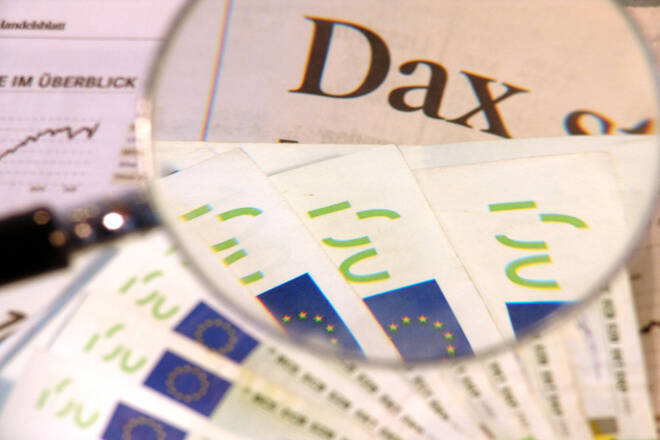Advertisement
Advertisement
DAX Faces a Testy Session with Stats and Central Banks in Focus
By:
It was a mixed Wednesday session for the DAX, which ended the day up by 0.08% to 15,909. Significantly, the DAX failed to strike a new 2023 high for the
It was a mixed Wednesday session for the DAX, which ended the day up by 0.08% to 15,909. Significantly, the DAX failed to strike a new 2023 high for the first time in four sessions.
UK and euro area inflation figures sent the DAX into negative territory. However, easing fears of a banking crisis supported bank stocks and a late recovery.
The latest inflation figures fueled bets on more hawkish central bank policy moves to tackle persistently elevated inflation.
UK and Euro Area Inflation Reignites Central Bank Jitters
Euro area inflation figures raised the threat of a 50-basis point ECB interest rate hike in May and further hikes in the summer.
In March, the annual inflation rate for the euro area softened from 8.5% to 6.9%, according to finalized numbers. However, the core inflation rate accelerated from 5.6% to 5.7%, leaving a 50-basis point interest rate hike on the table.
UK inflation figures added to the bearish mood. The annual inflation rate from the UK softened from 10.4% to 10.1% versus a forecasted 9.8%.
ECB Chief Economist Philip Lane responded to the inflation numbers, saying that further rate hikes are likely in the near term.
However, there were no economic indicators from the US to distract investors, leaving Fed chatter to draw interest.
Federal Reserve Bank of New York President John Williams spoke overnight, reportedly saying that inflation remains problematic and that the Fed will take measures to bring inflation to target.
According to the FedWatchTool, the probability of a 25-basis point May interest rate hike rose from 81.9% to 86.0% this morning versus 70.4% one week earlier.
The Market Movers
It was a mixed Wednesday for the auto sector. Continental and Volkswagen fell by 0.80% and 0.88%, respectively, with BMW ending the day with a 0.31% loss.
Mercedes-Benz Group and Porsche bucked the trend, with gains of 0.63% and 0.27%, respectively.
However, it was another bullish session for the banks. Commerzbank and Deutsche Bank rose by 4.50% and 0.93%, respectively.
The Day Ahead for the DAX
It is a busy day ahead on the economic calendar.
German wholesale inflation and euro area trade data will draw interest this morning. While the trade data influence, the German wholesale inflation figures will likely have more impact. Eurozone consumer confidence will also move the dial later in the session.
With inflation and monetary policy the focal point, the ECB’s monetary policy meeting accounts will also garner interest this afternoon. Considerations for the May interest rate decision and policy intentions beyond May will influence.
However, investors should monitor ECB commentary today. ECB President Christine Lagarde and ECB Executive Board member Isabel Schnabel are on the calendar to deliver speeches today.
It is also a busier day on the US economic calendar. Philly Fed Manufacturing Index figures for April and the all-important US jobless claims numbers will be in focus.
After a quiet first half of the week, we expect market sensitivity to the stats. Inflation and labor market components of the Index will draw interest alongside the jobless claim figures. Deteriorating labor market conditions could test the theory of a post-May Fed interest rate hike.
However, FOMC member commentary will also influence. FOMC members Waller and Bowman will deliver speeches overnight.
DAX Technical Indicators
Resistance & Support Levels
| R1 | 15,926 | S3 | 15,847 |
| R2 | 15,957 | S2 | 15,799 |
| R3 | 16,036 | S1 | 15,720 |
The DAX has to avoid the 15,878 pivot to target the First Major Resistance Level (R1) at 15,926. A move through the Wednesday high of 15,909 would send a bullish signal. However, the DAX would need euro area stats and central bank commentary to support a pre-US session breakout.
In the case of an extended rally, the bulls will likely test the Second Major Resistance Level (R2) at $15,957 and resistance at $16,000. The Third Major Resistance Level (R3) sits at 16,036.
A fall through the pivot would bring the First Major Support Level (S1) at 15,847 into play. However, barring a flight to safety, the DAX should avoid sub-$15,800 and the Second Major Support Level (S2) at 15,799. The Third Major Support Level (S3) sits at 15,720.
Looking at the EMAs and the 4-hourly chart, the EMAs send bullish signals. The DAX sits above the 50-day EMA (15,617). The 50-day EMA pulled further away from the 100-day EMA, with the 100-day EMA widening from the 200-day EMA, delivering bullish signals.
A hold above the Major Support Levels and the 50-day EMA (15,617) would support a breakout from R1 (15,926) to give the bulls a run at R2 (15,957) and 16,000. However, a risk-off event would deliver a fall through S1 (15,847) to bring S2 (15,799) into view. A fall through the 50-day (15,5617) would signal a near-term bullish trend reversal.
The DAX Futures Sees Red
Looking at the futures markets, DAX was down 4 points, with the NASDAQ mini falling by 45. The Dow mini was down by 11.
For a look at the economic events, check out our economic calendar.
About the Author
Bob Masonauthor
With over 28 years of experience in the financial industry, Bob has worked with various global rating agencies and multinational banks. Currently he is covering currencies, commodities, alternative asset classes and global equities, focusing mostly on European and Asian markets.
Advertisement
